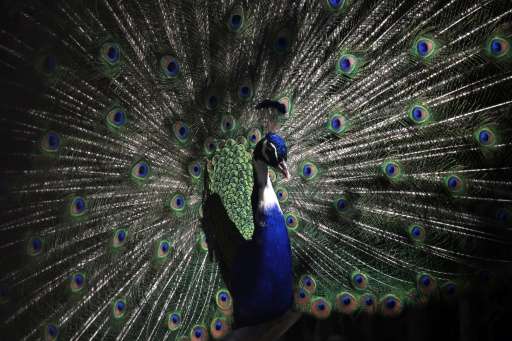Peacocks shake feathers to mesmerize mates

Call it a shimmy meant to hypnotize. When courting a female, peacocks fan their colorful rear feathers and shake them, but somehow keep their plumes' iridescent circles, or eyespots, nearly still, like a fixed stare.
It's a trick that is known to work with the ladies—who are known as peahens—researchers said Wednesday.
"This 'train-rattling' display attracts the peahen's visual attention and always precedes copulation," said the study in the journal PLOS ONE.
Charles Darwin first noted this chase-and-dance behavior a century and a half ago, but researchers have never fully understood how the biomechanics work.
So a team led by Roslyn Dakin from the University of British Columbia, Canada, studied the mating dance, in which the male shakes dozens of train feathers—each up to 1.5 meters long—and holds them erect for hundreds of hours of display each breeding season, which may last two to three months.
They used high-speed video to analyze the train-rattling movements in 14 adult peacocks.
Researchers also studied how individual feathers move in the lab.
They found that peacocks' eyespots can stay so still during displays because they "are locked together with microhooks much like those on flight feathers," said the study.
"This gives each eyespot greater density than the surrounding loose barbs, keeping it essentially in place as the loose barbs shimmer in the background."
Researchers also found that the longer a male's tail feathers, the faster he was able to shake them.
This effort would require more muscular strength, and might be a powerful signal of fitness to the females.
Most train feathers have a single eyespot at the end, and previous research has shown that "peacocks that display eyespots with greater iridescence obtain more matings."
The study was funded by the National Sciences and Engineering Research Council of Canada (NSERC).
More information: Roslyn Dakin et al, Biomechanics of the Peacock's Display: How Feather Structure and Resonance Influence Multimodal Signaling, PLOS ONE (2016). DOI: dx.doi.org/10.1371/journal.pone.0152759
Journal information: PLoS ONE
© 2016 AFP


















